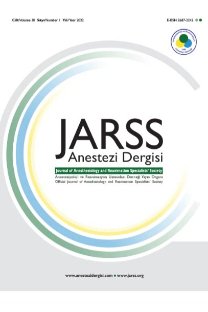Artroskopik Omuz Cerrahisi Sırasında İnterskalen Brakiyal Pleksus Bloğunun Analjezik ve Yan Etkilerinin Retrospektif Analizi
A Retrospective Analysis of the Analgesic and Adverse Effects of Interscalene Brachial Plexus Block During Arthroscopic Shoulder Surgery
___
- 1. Bruce BG, Green A, Blaine TA, Wesner LV. Brachial plexus blocks for upper extremity orthopaedic surgery. J Am Acad Orthop Surg 2012;20(1):38-47.
- 2. Borgeat A, Blumenthal S. Anaesthesia for shoulder surgery. Current Orthopaedics 2004;18(2):109-17.
- 3. Peruto CM, Ciccotti MG, Cohen SB. Shoulder arthroscopy positioning: lateral decubitus versus beach chair. Arthroscopy 2009;25(8):891-6.
- 4. Winnie AP. Interscalene brachial plexus block. Anesth Analg 1970;49(3):455-66.
- 5. Lenters TR, Davies J, Matsen FA 3rd. The types and severity of complications associated with interscalene brachial plexus block anesthesia: Local and national evidence. J Shoulder Elbow Surg 2007;16(4):379-87.
- 6. Bishop JY, Sprague M, Gelber J et al. Interscalene regional anesthesia for arthroscopic shoulder surgery: A safe and effective technique. J Shoulder Elbow Surg 2006;15(5):567- 70.
- 7. Misamore G, Webb B, McMurray S, Sallay P. A prospec- tive analysis of interscalene brachial plexus blocks per- formed under general anesthesia. J Shoulder Elbow Surg 2011;20(2):308-14.
- 8. Rohrbaugh M, Kentor ML, Orebaugh SL, Williams B. Outcomes of shoulder surgery in the sitting position with interscalene nerve block: A single-center series. Reg Anesth Pain Med 2013;38(1):28-33.
- 9. D’Alessio JG, Rosenblum M, Shea KP, Freitas DG. A retrospective comparison of interscalene block and general anesthesia for ambulatory surgery shoulder arthroscopy. Reg Anesth 1995;20(1):62-8.
- 10. Faryniarz D, Morelli C, Coleman S et al. Interscalene block anesthesia at an ambulatory surgery center performing predominantly regional anesthesia: A prospective study of one hundred thirty three patients undergoing shoulder surgery. J Shoulder Elbow Surg 2006;15(6):686-90.
- 11. Bert JM, Khetia E, Dubbink DA. Interscalene block for shoulder surgery in physician-owned community ambulatory surgery centers. Arthroscopy 2010;26(9):1149-52.
- 12. Tetzlaff JE, Yoon HJ, Brems J. Interscalene brachial plexus block for shoulder surgery. Reg Anesth 1994;19(5):339-43.
- 13. Moore DD, Maerz T, Anderson K. Shoulders surgeons’ perceptions of interscalene nerve blocks and a review of complications rates in theliterature. Phys Sportsmed 2013;41(3):77-84.
- 14. Pohl A, Cullen DJ. Cerebral ischemia during shoulder surgery in the upright position: A case series. J Clin Anesth 2005;17(6):463-9.
- 15. Rains DD, Rooke GA, Wahl CJ. Pathomechanisms and complications related to patient positioning and anesthesia during shoulder arthroscopy. Arthroscopy 2011;27(4):532- 41.
- 16. Bhatti MT, Enneking FK. Visual loss and ophthalmoplegia after shoulder surgery. Anesth Analg 2003;96(3):899-902.
- 17. Neal JM, Bernards CM, Butterworth JF 4th, et al. ASRA practice advisory on local anesthetic systemic toxicity. Reg Anesth Pain Med 2010;35(2):152-61.
- 18. Lansdown AK, McCartney CJL, Constantinescu CM, Patel SC. Regarding “a prospective analysis of interscalene brachial plexus block performed under general anesthesia”. J Shoulder Elbow Surg 2012;21(8):E16-7.
- 19. Kessler P, Steinfeldt T, Gogarten W, et al. Peripheral regional anesthesia in patients under general anesthesia: Risk assessment with respect to parasthesia, injection pain and nerve damage. Anaesthesist 2013;62(6):483-8.
- 20. Bogdanov A, Loveland R. Is there a place for interscalene block performed after induction of general anaesthesia? Eur J Anaesthesiol 2005;22(2):107-10.
- 21. Benumof JL. Permanent loss of cervical spinal cord function associated with interscalene block performed under general anesthesia. Anesthesiology 2000;93(6):1541-4.
- 22. Borgeat A, Ekatodramis G, Kalberer F, Benz C. Acute and nonacute complications associated interscalene block and shoulder surgery: A prospective study. Anesthesiology 2001;95(4):875-80.
- 23. Sulaiman L, Macfarlane RJ, Waseem M. Current concepts in anaesthesia for shoulder surgery. Open Orthop J 2013;7:323- 8.
- 24. Nishiyama T, Komatsu K. Local anesthetic toxicity in in- terscalene block: clinical series. Minerva Anestesiol 2010;76(12):1088-90.
- 25. Dillane D, Finucane BT. Local anesthetic systemic toxicity. Can J Anesth 2010;57(4):368-80.
- 26. Berde CB, Strichartz GR. Local anesthetics. In: Miller RD, Eriksson LI, Fleisher LA, Wiener-Kronish JP, Young WL, editors. Miller’s Anesthesia. 7th ed. Philadelphia: Elsevier, Churchill Livingstone, 2009;913-40.
- 27. Di Gregorio G, Neal JM, Rosenquist RW, Weinberg GL. Clinical presentation of local anesthetic systemic toxicity: A review of published cases, 1979 to 2009. Reg Anesth Pain Med 2010;35(2):181-7.
- 28. Brown DL, Ransom DM, Hall JA, Leicht CH, Schroeder DR, Offord KP. Regional anesthesia and local anesthetic-induced systemic toxicity: Seizure frequency and accompanying cardiovascular changes. Anesth Analg 1995;81(2):321-8.
- 29. Orebaugh SL, Kentor ML, Williams BA. Adverse outcomes associated with nerve stimulator-guided and ultrasound- guided peripheral nerveblocks by supervised trainees: update of a single-site database. Reg Anesth Pain Med 2012;37(6):577-82.
- 30. Walton KA, Buono LM. Horner syndrome. Curr Opin Ophthalmol 2003;14(6):357-63.
- 31. Stasiowski M, Zuber M, Marciniak R, et al. Risk factors for the development of Horner’s syndrome following interscalene brachial plexus block using ropivacaine for shoulder arthroscopy: A randomised trial. Anaesthesiol Intensive Ther 2018;50(3):215-20.
- 32. White L, Reardon D, Davis K, Velli G, Bright M. Anterior suprascapular nerve block versus interscalene brachial plexus block for arthroscopic shoulder surgery: A systematic review and meta-analysis of randomized controlled trials. J Anesth 2022;36(1):17-25.
- 33. Brull R, McCartney CJ, Chan VWS, El-Beheiry H. Neurological complications after regional anesthesia: Contemporary estimates of risk. Anesth Analg 2007;104(4):965-74.
- ISSN: 1300-0578
- Yayın Aralığı: Yılda 4 Sayı
- Başlangıç: 1993
- Yayıncı: Betül Kartal
Nosisepsiyonun Monitörizasyonu
Cengizhan YAVUZ, Hafize ÖKSÜZ, GOKCE GISI, Feyza ÇALIŞIR, Bora BİLAL, Can ACIPAYAM, Mahmut ARSLAN, Adem DOĞANER
Derya ÖZKAN, Gökhan ERDEM, Yasemin ERMİŞ
Gamze KÜÇÜKOSMAN, Alkım Gizem Yılmaz, Hilal AYOĞLU, Bengü Gülhan AYDIN, Hasan Ali AYDIN
Selin EREL, Dilek YENİGÜN, Naciye Turk OZTERLEMEZ
Julide ERGİL, Yusuf ÖZGÜNER, Savaş ALTINSOY, Mehmet Murat SAYIN, Derya GÜZELKAYA
ABDULLAH OMER ATSAL, Belgin AKAN, Handan ANKARALI, Canan ÇAM GÖNEN, Işıl ÖZKOÇAK TURAN, Duygu Kayar Calili
Platelet ve Ortalama Platelet Hacim Kinetiklerinin Ventilatör İlişkili Pnömoni İçin Prognostik Önemi
Karamehmet YILDIZ, Özlem ÖZ GERGİN, Recep AKSU, Oğuz Kaan Şimşek, Ednan BAYRAM, Sibel SEÇKİN PEHLİVAN
Abdulkadir BUT, Abdussamed YALCIN, Mehmet SAHAP, Merve SEVİM, Handan GULEC
